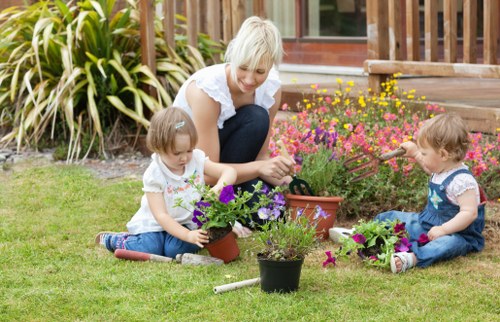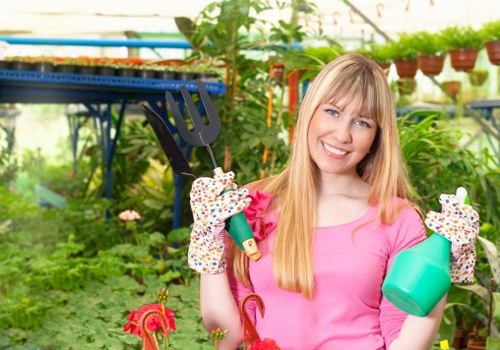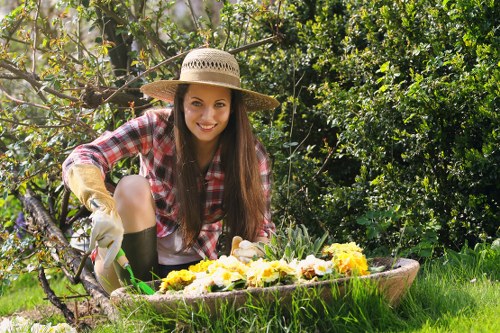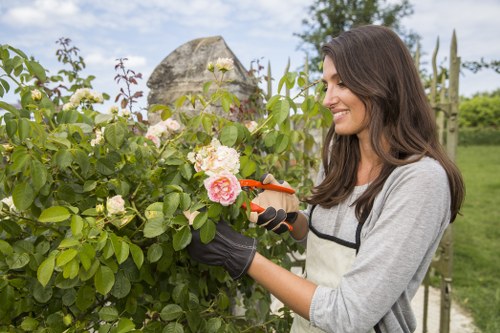Enhance Your Outdoor Space with a Garden Fencing Bow

Transforming your garden into a beautiful and functional space often starts with the right fencing. A garden fencing bow not only provides privacy and security but also adds a decorative element to your outdoor area. Whether you’re looking to create a serene retreat or a vibrant garden, the right fencing bow can make all the difference.
Choosing the perfect garden fence involves considering various factors such as material, design, and the overall aesthetic you wish to achieve. With so many options available, it can be overwhelming to decide which type of fencing bow suits your needs best. This article will guide you through everything you need to know about garden fencing bows, helping you make an informed decision.
Garden fencing bows come in a variety of styles, each offering unique benefits. From traditional wooden bows to modern metal designs, there’s something to fit every taste and budget. Understanding the different types will help you select the fencing bow that best complements your garden’s design and meets your functional requirements.
Types of Garden Fencing Bows

When it comes to garden fencing bows, the material you choose plays a significant role in both the appearance and durability of the fence. Here are some of the most popular materials used:
- Wooden Fencing Bows: Classic and versatile, wooden bows can be stained or painted to match your garden's palette. They offer a natural look and are relatively easy to install.
- Metal Fencing Bows: These bows provide a modern aesthetic and are extremely durable. Materials like wrought iron or aluminum are resistant to weather and require minimal maintenance.
- Vinyl Fencing Bows: Vinyl is a low-maintenance option that mimics the look of wood without the need for regular staining or painting. It’s also resistant to pests and rot.
- Composite Fencing Bows: Made from a blend of wood fibers and plastic, composite bows offer the look of wood with enhanced durability and resistance to the elements.
Each material has its own set of advantages, so consider your specific needs and preferences when selecting a garden fencing bow.
Another important factor is the design of the fencing bow. Designs range from simple and sleek to ornate and decorative, allowing you to choose a style that matches your garden’s overall theme.
Design Options for Garden Fencing Bows

The design of your garden fencing bow can greatly influence the overall look and feel of your outdoor space. Here are some popular design options:
- Traditional Styles: Featuring ornate details and classic patterns, traditional bows are perfect for gardens with a historic or cottage-style aesthetic.
- Modern Designs: Clean lines and minimalist shapes make modern fencing bows ideal for contemporary gardens.
- Rustic Options: Natural finishes and rough textures give a rustic charm, blending seamlessly with garden landscapes.
- Decorative Features: Incorporating elements like finials, scrolls, or lattice work can add a unique twist to your fencing bow.
Choosing a design that complements your garden’s existing elements, such as plants, pathways, and seating areas, will create a harmonious and inviting outdoor space.
Additionally, consider the height and length of the fencing bow. Taller fences provide more privacy and security, while shorter ones can serve as decorative boundaries or to delineate specific garden areas.
Installation and Maintenance

Installing a garden fencing bow can be a straightforward project with the right tools and preparation. Here are the basic steps involved:
- Planning: Measure your garden area to determine the length of fencing needed. Plan the layout to ensure even spacing and a cohesive look.
- Preparation: Clear the area of any obstacles and mark where each fence post will be placed. Ensure the ground is level for a stable installation.
- Installation: Dig holes for the fence posts, insert them, and secure them with concrete. Attach the fencing bow to the posts using appropriate hardware.
- Finishing Touches: Apply any desired finishes, such as paint or stain, and add decorative elements if needed.
Regular maintenance is essential to keep your fencing bow looking its best. Depending on the material, this may include periodic cleaning, repainting or staining, and checking for any signs of wear or damage.
For wood fences, treating with a sealant can prevent rot and insect damage. Metal fences might require rust prevention measures, while vinyl and composite fences typically need minimal upkeep.
Benefits of a Garden Fencing Bow

Installing a garden fencing bow offers numerous benefits beyond mere aesthetics:
- Privacy: A sturdy fence provides a barrier, creating a secluded space where you can relax without prying eyes.
- Security: Fencing can deter unwanted visitors and keep pets and children safe within your garden area.
- Wind Protection: A tall fence can act as a windbreak, protecting delicate plants and making your outdoor space more comfortable.
- Boundary Definition: Clearly defining the edges of your property can prevent disputes with neighbors and keep your garden organized.
- Enhanced Curb Appeal: A well-designed fencing bow can significantly boost the visual appeal of your home and garden.
These benefits make a garden fencing bow a valuable investment for any homeowner looking to improve their outdoor living space.
Moreover, a quality fencing bow adds to the overall value of your property, making it an attractive feature for potential buyers if you decide to sell your home in the future.
Choosing the Right Fencing Bow for Your Garden
Selecting the perfect garden fencing bow involves considering several key factors:
- Purpose: Determine whether you need the fence for privacy, security, decoration, or a combination of these.
- Material: Choose a material that suits your maintenance preferences and the climate in your area.
- Design: Select a design that complements your garden’s style and enhances its beauty.
- Budget: Establish a budget that covers both the materials and installation costs.
- Local Regulations: Check any local building codes or neighborhood guidelines related to fencing before making a purchase.
By carefully evaluating these factors, you can ensure that your garden fencing bow meets your needs and enhances your outdoor space effectively.
Additionally, consulting with a professional can provide valuable insights and help you avoid common pitfalls during the selection and installation process.
Local Areas Near Bow for Garden Fencing Needs
If you’re in Bow or nearby areas, you have access to a range of local suppliers and experts who can assist with your garden fencing bow needs. Here are some of the closest areas to Bow:
- Stratford: Just a short distance from Bow, Stratford offers numerous garden centers and fencing specialists to help you find the perfect bow for your garden.
- Poplar: Known for its vibrant community, Poplar has several local businesses specializing in both installation and maintenance of garden fences.
- Bethnal Green: This area provides a mix of traditional and modern fencing options, catering to diverse garden styles.
- East Ham: East Ham boasts a variety of materials for fencing bows, including eco-friendly and sustainable options.
- Wanstead: For those seeking high-quality, durable fencing solutions, Wanstead is home to reputable suppliers.
- Stratford: With its extensive market, Stratford is an excellent place to compare different fencing materials and designs.
- Canning Town: Canning Town offers competitive pricing and a wide selection of fencing bows to choose from.
- Forest Gate: Forest Gate’s local experts provide customized fencing solutions to match any garden’s unique requirements.
- Chadwell Heath: Known for its picturesque gardens, Chadwell Heath supplies fencing bows that enhance natural landscapes.
- Upton Park: Upton Park features contemporary fencing designs that blend seamlessly with modern garden setups.
- Ilford: Ilford offers both traditional and innovative fencing options, ensuring there’s something for every garden style.
- Upper Clapton: Upper Clapton is renowned for its sustainable fencing materials, ideal for eco-conscious gardeners.
- Bishop’s Park: With its lush green spaces, Bishop’s Park provides fencing bows that complement natural surroundings.
- Beckton: Beckton’s fencing suppliers specialize in durable and weather-resistant materials suitable for all climates.
- Hackney Wick: For unique and artistic fencing designs, Hackney Wick is the go-to place near Bow.
Each of these areas offers unique features and benefits, making them excellent choices for sourcing and installing your garden fencing bow.
Exploring local options not only supports community businesses but also ensures that you receive personalized service tailored to your specific garden needs.
Choosing the Right Color and Finish
The color and finish of your garden fencing bow play a crucial role in how it complements your garden’s overall design. Here are some tips to help you decide:
- Match Your Home’s Exterior: Choose a color that complements the exterior of your home for a cohesive look.
- Consider the Surroundings: Select colors that blend with your garden’s natural elements, such as greenery and flowers.
- Highlight Features: Use contrasting colors to highlight architectural features or decorative elements of the fencing bow.
- Maintenance: Darker colors might show weathering and dirt more easily, while lighter shades can mask these imperfections.
- Finish Options: Decide between a matte or glossy finish based on the desired aesthetic and durability.
Additionally, some materials like wood can be stained or painted in various colors, offering greater flexibility in design choices. Metal fences might come in powder-coated colors that resist fading and chipping.
Choosing the right color and finish not only enhances the beauty of your fencing bow but also ensures it stands up to the elements, maintaining its appearance over time.
Eco-Friendly Garden Fencing Options
For environmentally conscious gardeners, there are several eco-friendly garden fencing bow options available:
- Sustainably Sourced Wood: Opt for wood from certified sustainable forests to minimize environmental impact.
- Recycled Materials: Fences made from recycled metals or composite materials reduce waste and promote sustainability.
- Low-VOC Finishes: Choose paints and stains with low volatile organic compounds to reduce harmful emissions.
- Natural Finishes: Linseed oil or other natural finishes can protect wood without the need for synthetic chemicals.
- Solar-Powered Lighting: Integrating solar lights into your fencing design can enhance functionality while being energy-efficient.
Implementing eco-friendly fencing solutions not only benefits the environment but can also create a healthier garden space, free from harmful chemicals and toxins.
Moreover, sustainable fencing options often boast enhanced durability and lower maintenance requirements, making them a practical choice in the long run.
Cost Considerations for Garden Fencing Bows
Budgeting for a garden fencing bow involves considering both initial costs and long-term maintenance expenses. Here are some factors to keep in mind:
- Material Costs: Different materials come with varying price tags. Wood is often more affordable upfront, while metal and composite options might require a larger initial investment.
- Installation Expenses: Professional installation can add to the cost but ensures a properly secured and aesthetically pleasing fence.
- Maintenance Costs: Consider the ongoing maintenance required for each material. Low-maintenance materials like vinyl or composite can save money over time.
- Longevity: Investing in a durable fencing bow may have higher upfront costs but can reduce the need for frequent repairs or replacements.
- Additional Features: Decorative elements or custom designs can increase the overall cost, so factor these into your budget accordingly.
By carefully evaluating these cost factors, you can choose a garden fencing bow that fits your budget while still meeting your design and functional needs.
Remember to obtain multiple quotes from suppliers and installers to ensure you’re getting the best value for your investment.
DIY vs. Professional Installation
Deciding between a DIY installation and hiring a professional for your garden fencing bow depends on several factors:
- Skill Level: If you have experience with similar projects, a DIY approach can be rewarding and cost-effective.
- Time Commitment: DIY projects require time and effort. Professionals can complete the installation more quickly and efficiently.
- Tools and Equipment: Ensuring you have the necessary tools for a proper installation is essential for a successful DIY project.
- Complexity of Design: Intricate or large-scale fencing bows may benefit from professional expertise to achieve the desired finish.
- Cost: While DIY can save on labor costs, hiring a professional ensures the job is done correctly, potentially avoiding costly mistakes.
Ultimately, the choice between DIY and professional installation depends on your personal skills, available time, and the specific requirements of your garden fencing project.
Regardless of the method you choose, ensuring that the installation is done correctly is crucial for the longevity and functionality of your fencing bow.
Enhancing Your Garden with Complementary Elements
A garden fencing bow is just one element of creating a beautiful outdoor space. Here are some complementary features to consider:
- Garden Gates: Coordinating gates provide easy access and enhance the overall look of your fencing.
- Lighting: Integrating lights into your fence can add ambiance and improve safety during evening hours.
- Climbing Plants: Vines or flowering plants growing along your fence can add natural beauty and privacy.
- Ornamental Features: Adding decorative post caps or finials can enhance the aesthetic appeal of your fencing bow.
- Seating Areas: Creating spaces near your fence for seating allows you to enjoy your garden from different perspectives.
These elements work together to create a cohesive and inviting garden environment, making the most of your outdoor living space.
Additionally, thoughtful landscaping and strategic placement of garden features can highlight the beauty of your fencing bow and create a harmonious balance within your garden.
Common Mistakes to Avoid
When installing a garden fencing bow, avoiding common mistakes can save you time, money, and frustration:
- Poor Planning: Failing to measure accurately or neglecting to plan the layout can lead to uneven or misplaced fencing.
- Choosing Inappropriate Materials: Selecting materials that are not suited to your climate or maintenance preferences can result in premature wear and tear.
- Ignoring Local Regulations: Not adhering to local building codes or neighborhood guidelines can lead to fines or the need to remove the fence.
- Skipping the Preparation Phase: Properly preparing the site and ensuring stable foundations is crucial for a long-lasting fence.
- Overlooking Aesthetic Cohesion: Ensuring the fencing bow complements your garden’s overall design is essential for a harmonious look.
By being aware of these common pitfalls, you can ensure a smoother installation process and a more satisfying end result.
Taking the time to plan and execute your garden fencing project carefully will pay off in the long run, providing both beauty and functionality to your outdoor space.
Conclusion
A garden fencing bow is a versatile and valuable addition to any garden. It offers a blend of functionality and aesthetic appeal, enhancing the beauty and security of your outdoor space. By carefully selecting the right material, design, and installation method, you can create a fence that not only meets your practical needs but also complements your garden’s unique style.
Whether you choose a traditional wooden bow or a modern metal design, the right fencing can transform your garden into a more enjoyable and inviting place. With proper planning and maintenance, your garden fencing bow will remain a stunning feature of your home for years to come.
Embrace the potential of your garden by investing in a fencing bow that reflects your personal style and meets your specific requirements. Your outdoor sanctuary awaits!
Frequently Asked Questions
1. What is the best material for a garden fencing bow?
The best material depends on your specific needs and preferences. Wood offers a classic look, metal provides durability, vinyl requires low maintenance, and composite combines the appearance of wood with enhanced durability.
2. How high should a garden fencing bow be?
The height of your fencing bow depends on its purpose. For privacy, a height of 6 feet is common, while decorative or boundary fences can be shorter, around 3 to 4 feet.
3. Can I install a garden fencing bow myself?
Yes, if you have some DIY experience and the right tools. However, for complex designs or large installations, hiring a professional may be more efficient and ensure a high-quality finish.
4. How do I maintain a wooden garden fencing bow?
Regular maintenance includes staining or painting to protect against weathering, checking for and repairing any damage, and treating the wood to prevent rot and insect infestation.
5. Are there eco-friendly options for garden fencing bows?
Yes, eco-friendly options include sustainably sourced wood, fencing made from recycled materials, and using low-VOC finishes to reduce environmental impact.